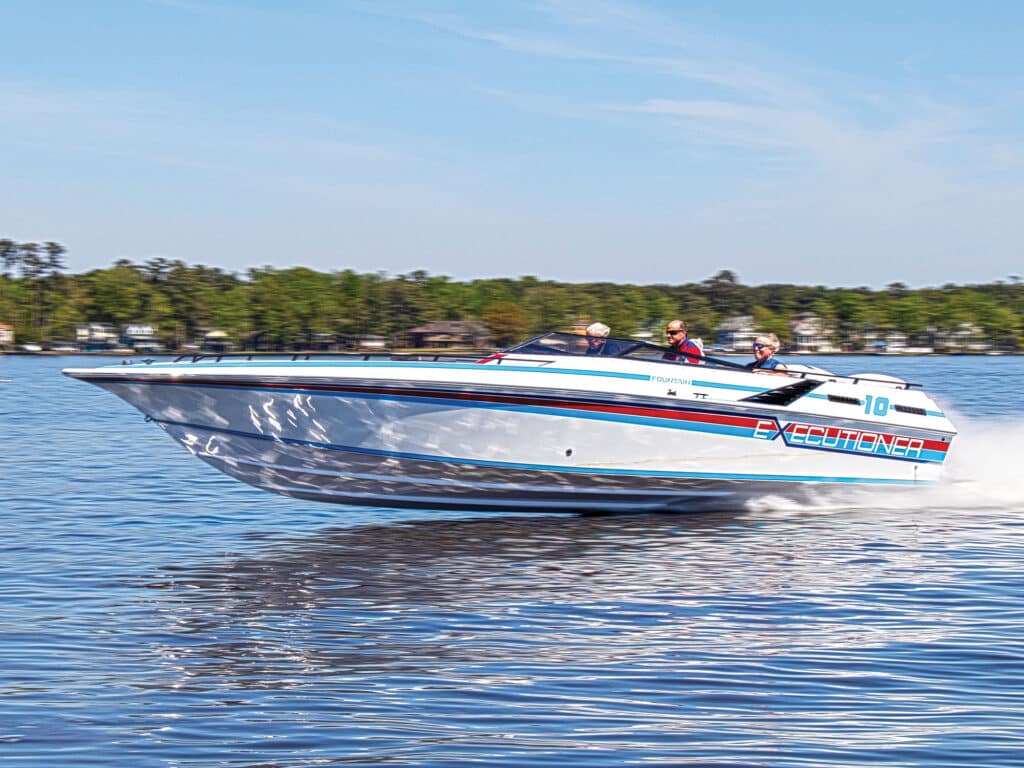
Who is the OG of performance powerboating, the founder of go-fast? Gar Wood, Ray Hunt, Jim Wynne, Don Aronow, Art Carlson and Larry Smith immediately come to mind, and all were certainly influential. But only one builder put his name on the “fastest, safest and best-handling boats in the world.” Reggie Fountain Jr. designed, built and raced the boats that bear his name, and made a staggering impact on the sport in the process. His influence started in 1980 with the creation of the Fountain 10 Meter Executioner, 33 feet of go-fast sizzle that rocked the performance world. This is the story of how that first boat was created, how it came back to Fountain, and what it took to repower a 43-year-old performance boat.
The Origin Story
In 1979, Reggie Fountain Jr. had earned a law degree, was a successful Northwestern Mutual insurance agent, was investing in real estate in his hometown of Washington, North Carolina, and was a national and world champion tunnel-boat racer as a member the Team Mercury factory effort that dominated the sport. When Mercury disbanded the race team during the Arab oil embargo, it was racing-team manager Gary Garbrecht who suggested that Fountain consider building offshore-style performance boats powered by the same Mercury high-performance engines he was supplying to Cigarette.
Fountain owned an outboard-powered 20-foot Allison Craft runabout, a boat that could hit 90 mph on the smooth waters of the Tar River thanks to its keel pad and notched transom. In the movie King of Offshore, Fountain recounts how he sought to adapt the Allison Craft features to a larger hull suitable for bigger waters. He partnered with Bill Farmer and Don Abel, custom boatbuilders from Sarasota, Florida, who modified the mold for their 31-foot Excalibur model, originally designed by Jeane Claude Simone, to Fountain’s specifications. At speed, the boat would skim along on its flat pad at the aft keel. The running surface ended short of the transom to create a built-in setback for the drives, which could then mount higher to reduce drag while keeping the props in solid water. Fountain called this exciting new boat the Excalibur Executioner.
Fountain sold 10 or 12 Executioner boats, but concluded that the flat pad slapped the water in choppy conditions. He went back to Farmer and Abel, and asked them to change the mold to add a modest V-angle to the pad. Having already cut up their mold once for Fountain, they declined to do it again. Undeterred, Fountain went back to Washington, rented an empty car-dealership building, and made his own mold by splashing one of the Executioner hulls. Helping in this project was then-17-year-old Jeff Harris, a Washington high school student who worked on Fountain’s racing pit crew.
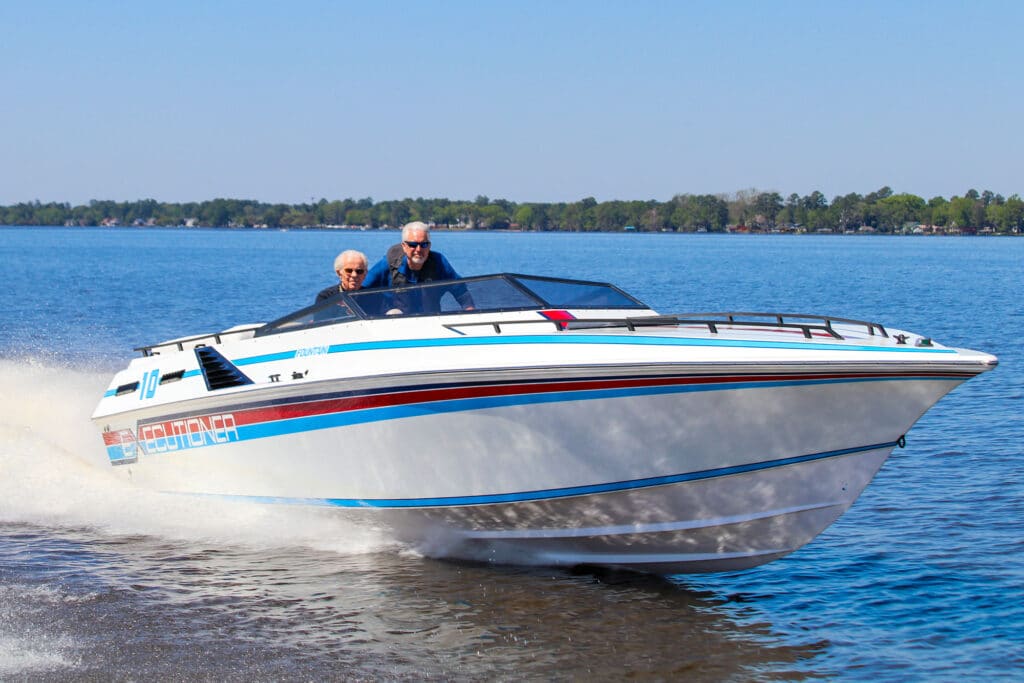
“I can still point to the spot on the floor in that building where we cut and shaped the mold,” says Harris, who became a national and world champion boat racer himself and is COO of Iconic Marine Group, owner of the Fountain brand. “Reggie added some V-shape to the pad to stop the slap and extended the bow to add some additional flare for an aerodynamic effect, the idea being that the flare would generate lift and could help keep the bow from stuffing in some conditions. The hullsides and deck were cored with Baltek balsa, which made the boat much stiffer. At the time, I believe only Cigarette was coring a production boat.”
The pointed bow—the Fountain “beak”—became a distinctive design feature of every Fountain model. It made the boat length 33 feet, or 10 meters. The boat was powered by a pair of 475 hp Mercury high-performance 454-cubic-inch engines fitted with Gale Banks twin turbocharger kits and Mercury TRS No. 2 Speedmaster drives. Garbrecht arranged to have the boat dialed in at the Mercury Lake X test center in Florida, where it ran an impressive 88 mph. The first Fountain 10 Meter Executioner was finished in medium blue with white stripes and delivered in 1980 to its new owner, a New York investment banker. Fountain got busy building boat No. 2.
Hull No. 1 Returns
Over the years, hull No. 1 would occasionally come back to the Fountain shop in Washington for service or a refresh, and it was repowered at least once. In 1998, the owner contacted Reggie Fountain and asked for help selling the boat. Fountain instead purchased it and had it repainted in a red, white and blue scheme typical of Executioner models of the 1980s
“Reggie would use the boat maybe once a year,” Harris says. “It was often in the way and would be moved around the property, sometimes left outside.”
Fountain Powerboats did not survive the 2008 economic downturn, and declared bankruptcy in 2009 and again in 2012, with Reggie now out of the company. Along the way, hull No. 1 ended up on display at a Fountain dealership in the Midwest. Fred Ross, owner of Big Thunder Marine in the Lake of the Ozarks region, acquired the boat in 2017 before he purchased the assets of the Fountain, Baja and Donzi brands, and formed Iconic Marine in 2018. Ross invited Fountain to a poker-run event at Big Thunder, where the boat was displayed. After noting Fountain’s nostalgia for the Executioner, Ross gifted the boat back to him.
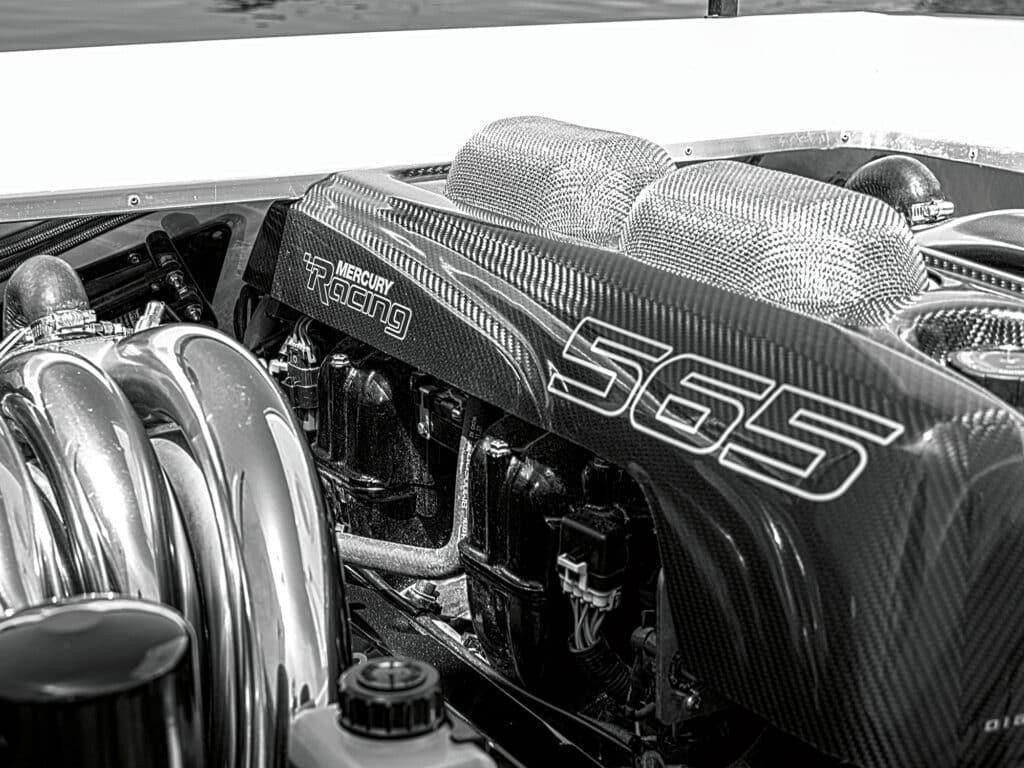
Time to Repower
By then the boat ran, but not well, and was looking a bit shabby. The Executioner was refinished in its current retro paint scheme and fitted with a new matching interior. A repower and rigging update were in order, and those tasks were accomplished by BAR Marine of Jacksonboro, South Carolina, a Mercury Racing dealer owned by Ben Robertson Jr., himself a former tunnel-boat and offshore racer who has worked with Reggie Fountain in the past. The project illustrates the challenges of repowering a classic sterndrive performance boat.
Robertson has rigged and raced Fountain 29- and 35-foot Factory II race boats and repowered many older Fountain boats—there are currently more than 20 waiting their turn in the BAR yard—so he knows how these boats go together.
“When we got the boat, the engines were out,” Robertson says. “There was a lot of evident wear and tear, but the boat was really solid, with no rot in the plywood stringers or the transom. We started by stripping out all of the analog rigging, as the repower would be digital. Then we pulled out the cockpit carpet, sanded down the sole, and refinished it with gelcoat.”
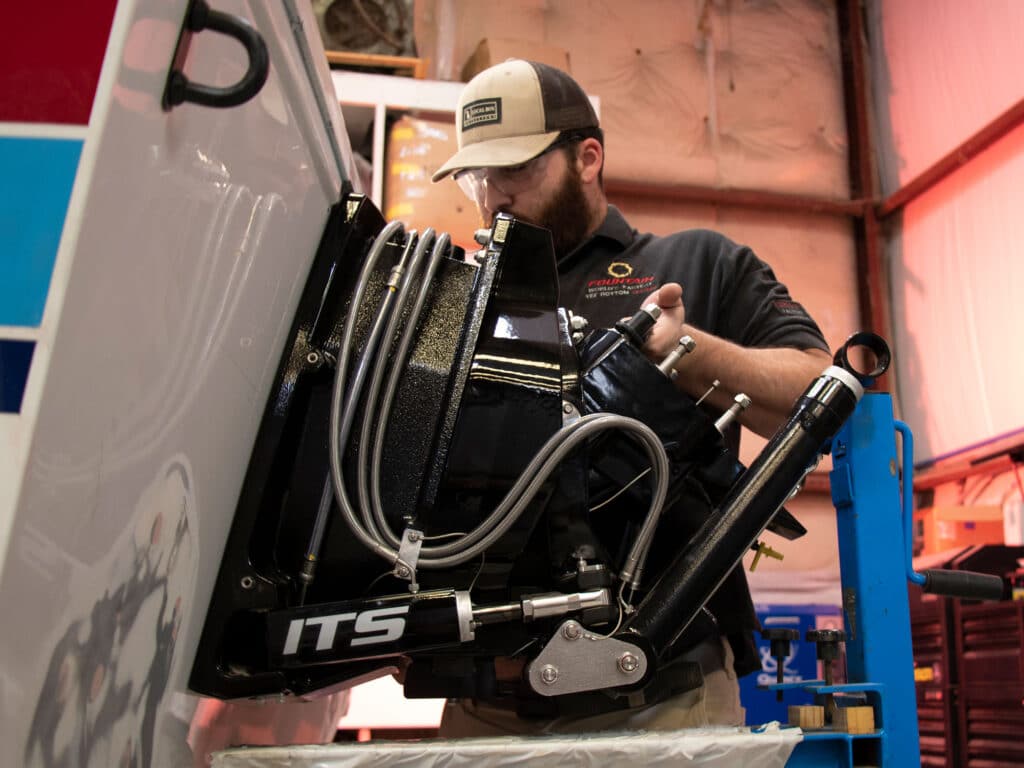
Next, the stripped-out engine bay and transom were scanned using a Faro 3D digital scanner. The data from that was placed in a CAD program at Charleston Composites, a business affiliated with BAR Marine. A specialized marine digital design program was then used to calculate the placement of engine mounts and the X dimension for installing the drives on the transom.
Locating the drives is the first step. The holes for the old TRS are not compatible with Mercury Racing Bravo drives, so the transom cutouts had to be filled with new plywood, reinforced inside the boat, and reglassed and finished. The original trim tabs were removed, and those mounting holes also filled. For this repower, a package of Mercury Racing Bravo One XR Sport Master 1.5-to-1 drives with an Integrated Transom System (ITS) was selected. The ITS sets the drive back about 7 inches and features integral power-steering cylinders for a cleaner look and easier installation. With the desired drive height depicted in CAD, the team determined it had to cut away a few inches of the edge of the deck to fit the ITS mounting plate before making the new transom cutouts with a reciprocating saw. Finally, the ITS units and drives could be installed. This determines the engine mounting height because the output from the engines needs to align with the drives.
“Next, we had to modify the stringers and make new engine mounts because the old mounts don’t fit modern engines,” Robertson says. “We had to add material to raise the center stringer and lower the outers, but not by much. Then we made new aluminum engine mounts in the same style as the originals.”
The CAD files are so accurate that the BAR team knew the molded carbon-fiber engine covers on top of the 8.7-liter V-8 naturally aspirated Mercury Racing 565 engines would not quite fit below the aft edge of the engine hatch, and each cover was trimmed before the engines were installed. It appears that a sheet of paper might just fit between the inboard exhaust headers, and Robertson explains that he tries to get the engines, and thus the drives, as close together as possible to keep the props in the best water. The centers on this rig are 33.5 inches. New Mercury Racing K-Plane 380 tabs were installed in a horizontal position, rather than the original alignment with the bottom of the transom.
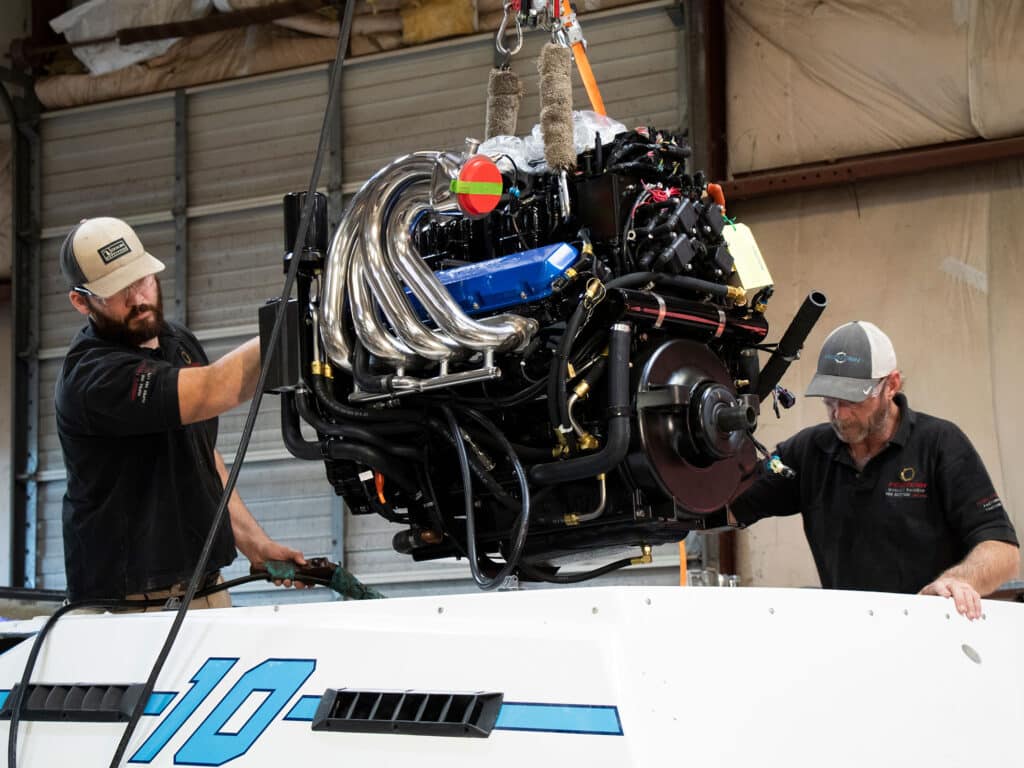
Robertson says the most frustrating element of this repower was fitting the exhaust tailpipes, which must be custom-made for older boats like this Fountain. New boats typically mate the 4.5-inch headers to 4-inch tailpipes, with water injected into the exhaust flow to muffle sound.
“That tailpipe requires a lot of pieces, rubber boots and the water lines, and I just don’t like the way it looks,” Robertson says. “It’s not as clean as a race boat. We wanted dry tailpipes and waited months for a big supplier that just couldn’t come through. We finally went to Hardin Marine, which made up the water-jacketed pipes we wanted. It’s a little loud, but Reggie likes it.”
With all of the old analog instruments and controls removed, a new carbon-fiber dash from Innotech Products was fitted, with cutouts for a Garmin 8612 multifunction display and a Mercury VesselView 4 display, a Livorsi digital drive and tab-trim indicator, and Livorsi digital controls. Robertson is a big fan of MDC TrimSync programmable auto trim and installed that system on the Fountain with a control toggle next to the original trim toggle switches. The wheel is an older Second Effort unit from one of Robertson’s tunnel-hull race boats, with trim switches on each of the three spokes.
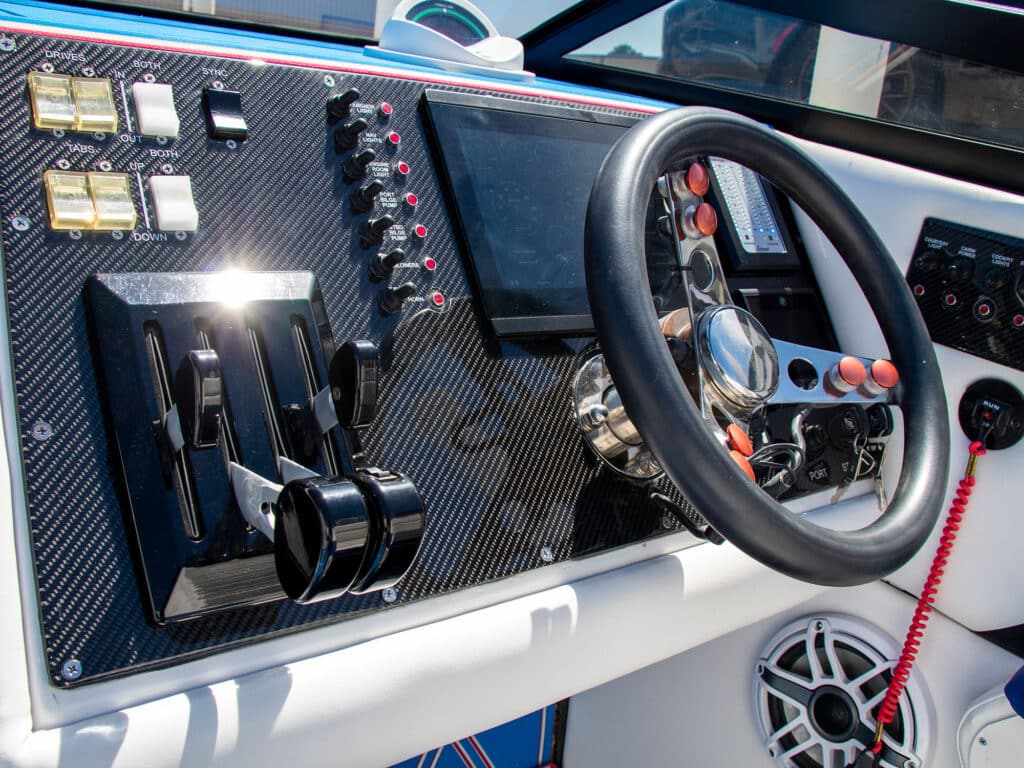
Nick Petersen, Mercury Racing prop manager, helped Robertson select 15.25-inch-by-30-inch Maximus ST Lab Finish propellers, a complicated task when repowering an older boat.
“Being a larger, stern-heavy boat, we typically opt for the Maximus over the Bravo One or Max5 prop models,” Petersen says. “The drives aren’t mounted super high, and the boat needs more bow lift at speed than some of the newer hulls, so we went with the 15.25-inch diameter instead of the full 15.63-inch model with the shorter tube. The barrel length of the Maximus is still longer than the standard Max5 and also has more blade area.”
The bottom line is that every repower project is unique. Robertson ballparks the bill for this project at about $335,000, including the powertrain, electronics, rigging and labor. Mercury Racing sells the 565 engine, ITS and Bravo XR Sport Master drive as a package for $79,830, so figure about $160,000 for the powertrain alone.
Read Next: Fountain 42 Lightning
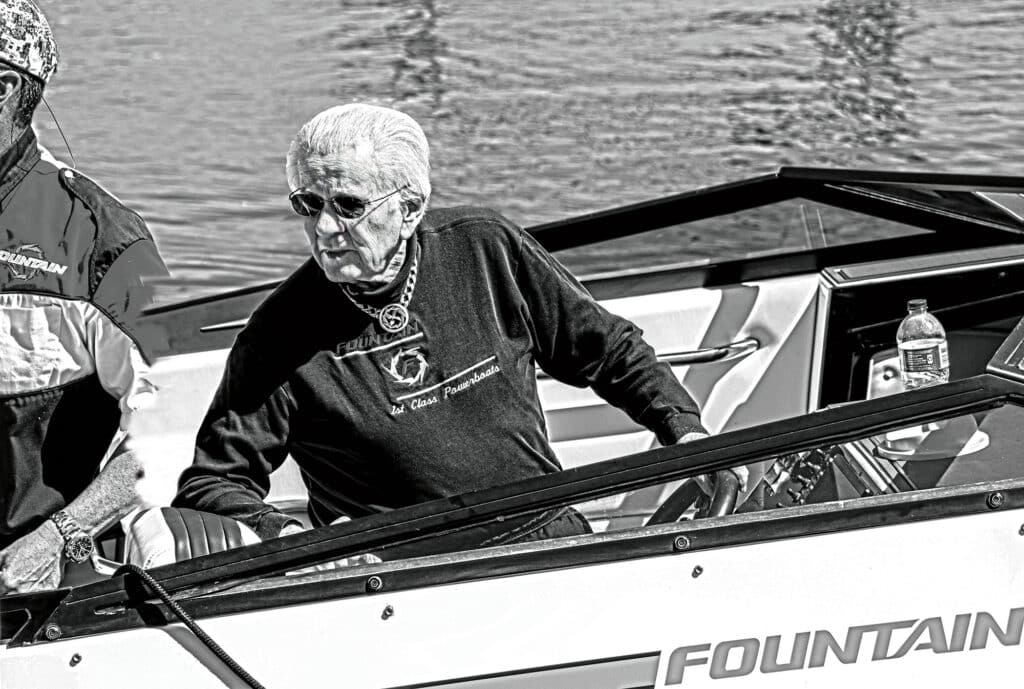
Robertson’s experience and his team’s expertise played a big part in this project. The payoff was a boat that ran and handled well right off its new custom EZ Loader C-channel aluminum trailer.
“You could go with more power, but I really like these 565 engines,” Robertson says. “They are easy to install, make great torque, and run on 89-octane fuel.”
Robertson has satisfied a demanding customer. On April 12—his 83rd birthday, by the way—Reggie Fountain Jr. took the throttles for the first time and trimmed the repowered hull No. 1 to perfection for a 91 mph blast down the Pamlico River. Then he turned around and did it again. We were along for the ride, and it was quite a thrill.









